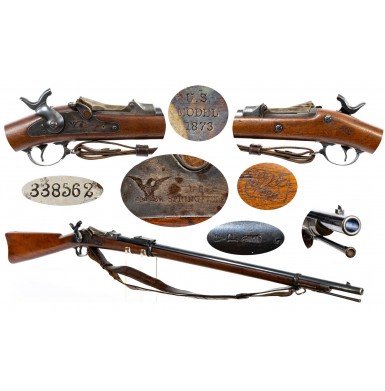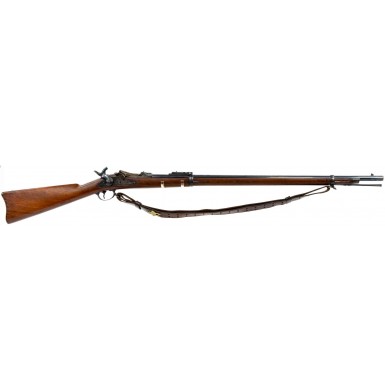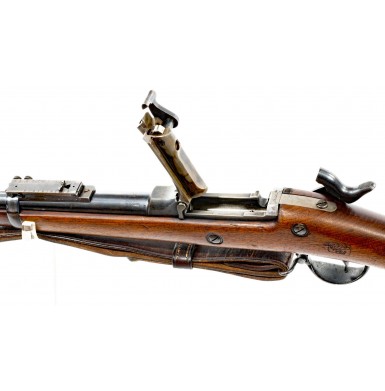Fine US Model 1884 Trapdoor Rifle - First Year of Production
- Product Code: FLA-3610-SOLD
- Availability: Out Of Stock
-
$1.00
The conclusion of the American Civil War not only ended the open military conflict between the United States and the southern Confederacy, it also ended the age of the percussion ignition, muzzleloading rifle musket as the primary infantry weapon of war. The Civil War had proven that the breechloading firearm, utilizing a self-contained metallic cartridge, was certainly the new king of the battlefield. However, the newly victorious United States found themselves with a massive debt load incurred by the war and an equally massive inventory of muzzleloading percussion long arms that were not completely obsolete. Even as the war was drawing to a close, the Ordnance Department was looking for a way to upgrade the stocks of obsolete arms to cartridge breechloaders, as they had no funding to procure new arms. To that end, on September 19, 1865 Erskine S. Allin, the Master Armorer at the Springfield Armory, received US Patent #49,959 for his Improvement in Breech-Loading Fire-Arms and what would be known as the Trapdoor system was born.
Allin’s idea was not particularly unique or innovative, as hinged breechblocks to allow loading a cartridge, whether paper or metallic, had been around for decades. However, it was a simple, cost effective solution to the alteration of muzzleloading arms to breechloading and allowed the use of much of the existing firearm, requiring a minimal number of new parts to be fabricated. To put it in the most basic of terms, a new breechblock was built, with a hinged door that opened the block to allow loading and unloading of the firearm. The old muzzle-loading barrel had its original breech cut off, the rear end threaded, and was then threaded into the new breechblock. The stocks were modified to accept the new, larger breechblock, and new cartridge hammers were added to the lock, replacing the old percussion ones. After the modification was complete the old muzzleloader was a new breechloader. Allin was not working in a vacuum, and other inventors around the world were all working on similar concepts. Within a year or two of Allin’s patent, the Belgian Albini-Braendlin, Swiss Milbank-Amsler, Austrian Wänzl, American Berdan, British Snider and French Tabatière systems were all patented and into production. All were variations on the same basic theme of a hinged breechblock that could be added to the old percussion gun to retrofit it into a cartridge breechloader. Most had blocks that opened upward and forward, towards the muzzle, but some like the Snider and Tabatière systems were hinged to open to the side. It is likely that all of these designs influenced each other in various ways, and that all of the inventors “borrowed,” or outright stole, ideas from each other.
The first of the US alterations, known as the Model 1865, or “First Allin Conversions” were produced in 1865. Some 5,000 US M1861 Rifle Muskets were altered at Springfield to the new “Trapdoor” system. These guns were chambered for a .58 rimfire cartridge and used the original bore diameter and rifling. After some trials and use in the field, an improved version of the gun with a new cartridge was adopted the following year. The US Model 1866 or “Second Allin Conversion.” This was the first of the series of arms to use the newly adopted .50 Government centerfire cartridge, also known as the .50-70. The breech blocks were improved with a new internal extractor systems and new center fire firing pins. The .58 barrels were sleeved to .50 caliber to make the new cartridge usable in the old barrels. Over the next two years some 25,000 M1866 long arms would be produced at Springfield by modifying existing stocks of M1863 and M1864 rifle muskets for use by the post-Civil War army.
In 1868, a new and improved variant of the M1866 was adopted, the Model 1868. The most obvious difference between the M1866 and M1868 was that the new model had a shorter barrel with only two barrel bands instead of three. Up until this point, the altered M1865 and M1866 rifles had retained the old Civil War musket overall length with barrels that were nominally 40” in length including the newly added breechblock (36 /58” to the breech face), and that were secured by three barrel bands. The new M1868 used a 32 ½” barrel that was secured by only two barrel bands. While existing stocks of parts continued to be used as much as possible with the M1868 Rifles, more newly made parts began to be used in the construction of the M1868. This included a new folding leaf rear sight and new pattern of cleaning rod. Despite the use of many older parts, the M1868 rifles could no longer be considered “alterations” of existing muskets but were newly made rifles. Between 1868 and 1870 some 51,000 of the new pattern long arms would be produced at Springfield.
In 1870, the last of the .50-70 “Trapdoors” was introduced, the Model 1870. Other than some minor changes in the machining of some parts like the interior arch of the breechblock and some minor engineering changes, the M1870 closely resembled the M1868. Again, more newly made new parts were being used in the production of these guns and fewer of the older Civil War period parts were incorporated. Like the M1868 Rifles, these were newly made guns rather than alterations of older ones. Only about 11,000 M1870 long arms would be produced before this pattern was replaced by the new Model 1873 Trapdoor in the new .45-70 caliber.
In 1872, the Ordnance Department convened a board of officers under the direction of General Alfred Terry to investigate the best design to be adopted for an infantry rifle and cavalry carbine. In addition to selecting a pattern and action system the board would also determine best caliber for the weapon as well. The Terry Board studied ninety-nine submissions from nearly every major American arms manufacturer as well as from hopeful inventors and some foreign submissions. In the end, the 1873 report from the board selected the Allin designed Trapdoor system and a new cartridge was adopted, the .45 Government, or .45-70. The reasons for recommending the Allin design were myriad, but essentially came down to the fact that the patent was held by the Master Armorer of Springfield, and as a government employee the design technically belonged to the government. Over the next two decades, the Board of Ordnance would flirt with various patent arms designs, from Hotchkiss, Lee, Chaffee-Reese and others, but would not abandon the Trapdoor system until the early 1890s, when it had become as obsolete as the muskets it had replaced some thirty years earlier.
The new .45-70 US Government rifle was designated the Model 1873. Like the .50-70 variants before it, the new .45-70 rifle would undergo numerous improvements during the more than two decades of service for this pattern of arm. The upgraded and improved versions would be designated the Models 1877, 1879, 1884 and 1888, without listing any of the limited production or experimental variants. Roughly 73,000 M1873 long arms were produced between 1873 and 1877, some 25,000 Model 1877 pattern arms were produced circa 1877-1878 and some 160,000 M1879 arms were produced between 1879 and 1885. More than 232,000 Model 1884 long arms were manufactured between 1886 and 1891 and some 65,000 Model 1888 arms were produced between 1889 and 1893. With all makes, models, experimental and variant .45-70 Trapdoor patterns produced, approximately 600,000 long arms rolled off the assembly line at Springfield in the two decades between 1873 and 1893.
The most notable physical changes took place between the M1873 and M1877 pattern arms. The M1873 had a short 9” comb and a long slender wrist that was prone to breakage. The 1877 variant lengthened the comb to 10 ½” and thickened the wrist to increase its strength. The M1873 had a “high arch” breech, with a large amount of metal removed from the arch found underneath the trapdoor block. The M1877 variant removed less metal, resulting in the “low arch” breech. The next variant, the Model 1879 series of arms introduced a thicker, sturdier receiver and upgraded and improved the rear sight and started the beginning of period experimentation with this particular part that would continue for several years. Numerous small parts changes and improvements took place during this period, including improvements in the extraction system, which had been consistently problematic and was partly responsible for issues that Custer’s troopers experienced with their guns at the Little Big Horn. Through the Models 1873, 1877 and 1879, the same Model 1873 designation was stamped on the breechblock. Additionally, old parts tended to be used up prior to including a newly designed part, so sometimes older pattern parts were used to complete early production new pattern guns and newly adopted changes were rarely implemented immediately into production, but rather were phased in over time.
In 1884, the most refined version of the rifle was adopted the Model 1884. This version was culmination of all of the experimentation and modifications tried with the earlier pattern guns and had some ten years of field trials behind it. Although the Model 1888 would replace the Model 1884 in 1889, the primary change with the new model was the adoption of a sliding ramrod bayonet that replaced the traditional socket bayonet, an “improvement” that few users in the field considered such. The primary upgrade for the M1884 rifle was the Buffington rear sight that allowed for precise adjustment for both windage and elevation. The M1884 also introduced new breech block model designation markings for the first time since the Model 1873 with Model 1884 being used on this model and through the end of production. As with other changes and upgrades the new model marking was applied after existing stocks of 1873 marked breech blocks were used up, thus early production M1884 rifles produced in 1886 and early 1887 usually have 1873 marked breech blocks.
Offered here is a FINE condition example of an early production US Model 1884 Trapdoor Rifle. These guns were the mainstay of the US military from the end of the Indian Wars period through the Spanish American War, despite the adoption of the Model 1892 Krag Rifle. More M1884 Rifles were produced than any of the other patterns and it is probably the most representative of the “Trapdoor” model rifles.
This US Model 1884 Rifle is serial number 338562 and was produced in 1886, the first year of Model 1884 production. As is typical of 1886 (and early 1887) produced Model 1884 rifles, the breech block retains the older Model 1873 markings. The block is clearly marked in three lines: U.S. / MODEL / 1873. The lock is marked with a {Spread-Winged Eagle} and in two lines: U.S. / SPRINGFIELD. The barrel shows the expected V / P / {Eagle Head} proof marks, as well as an additional P indicating the barrel had been joined to a receiver and tested and a small A inspection. The belly of the stock is marked with the {Circle-P} firing proof and a clear and the crisp script SWP /1886 cartouche of Springfield Master Armorer Samuel W. Porter is present at on the left side of the stock, opposite the lock.
The rifle retains most of the arsenal blued finish on the barrel and furniture with about 75%-80% of the original blue on the barrel, which is thinning and fading. The blue shows wear and some scattered surface oxidation and tiny patches of surface roughness here and there. Otherwise the barrel remains mostly smooth. The lock shows less finish, with scattered flecks of oxidation, some pinpricking and some small areas of light pitting. The lock has been cleaned around the markings to make them more visible and leaving a dull pewter gray patina in that area, as well as some surface scuffs. The low arch breech block retains about 60%-70% of the original vivid case coloring with fading and dulling, particularly around the edges and some scattered flecks of oxidized discoloration here and there. The metal also shows some scattered minor impact marks and dings from handling, storage and use. All markings remain clear in the metal and the action remains mechanically crisp and fully functional. The grooved trigger operates correctly and the three-click tumbler locks securely into all positions. The bore of the rifle remains in FINE condition as well. It is mostly bright with some frosting and light oxidation here and there, most notably in the last 3”-4” nearest the muzzle. The bore shows no pitting to speak of but there is some minor roughness near the muzzle. The gun retains the original and correct “R” marked M1884 Buffington rear sight, both sling swivels and the stacking swivel and an original and correct pattern cleaning rod. The buttplate is solid and without a trapdoor as is correct. This storage compartment would not be added to the rifle until the Model 1888, although it was standard on carbines from the Model 1877 onward. The stock is in FINE condition as well. It is solid and full-length and free of any breaks, cracks or repairs. The stock retains a fine and crisp cartouche and a slightly lighter {Circle-P} mark. The stock shows no signs of sanding and retains fine lines. The wood does show scattered bumps, dings and handling marks, but shows no signs of abuse.
The rifle includes a FINE condition original US Pattern 1887 Rifle Sling. The 1887 sling was adopted in that year to replace the US M1870 sling. The original 1870 sling had been produced by sewing two obsolete US Pattern 1857 musket slings together and was later produced new as a one-piece version. The 1887 sling introduced the double-brass hooks that would be standard on the hardware of leather US rifle slings through the World War II era. The 1887 sling would be standard for late issue Trapdoor Rifles and the various US Krag rifles and would eventually be replaced for the US M1903 rifle by the M1905 Sling. The sling is in FINE condition remaining solid and complete but showing light to moderate wear and some finish loss and light crazing. The sling shows no excessive wear or abuse. The sling is quite pliable and remains usable and could also be removed for use on another rifle.
Overall this is a really fine and attractive example of a late Indian War period US Model 1886 Trapdoor Rifle from the first year of production. The gun is 100% complete and correct, is fully functional, has a fine bore and is accompanied by a fine sling. This rifle would be a fine addition to any collection of Indian War era arms and is certainly one that any collector would be proud to own.
SOLD
Tags: Fine, US, Model, 1884, Trapdoor, Rifle, First, Year, of, Production












